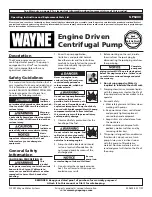
12
B
A
B
A
B
A
B
A
Figure 15 - Manifold Assembly
6.
Remove the bolts and sealing washers securing the hydraulic
manifold and cover plate to the hydraulic reservoir. See
Figure 15.
NOTICE
Hydraulic manifold and cover plate assembly weighs
approximately 20 lb. [9 kg]. Manifold mounted control valves will
add additional weight.
7. Carefully lift the manifold and cover plate assembly straight
up until it is removed from the hydraulic reservoir. See Figure
15. Set this assembly aside, in a clean and dry location.
8. Install caps or plugs over all open fi ttings to prevent dirt
entry.
9.
Inspect the hydraulic reservoir. Remove any sludge or debris
from the reservoir interior.
10. Unscrew and remove each oil suction strainer. Discard both
used suction strainers. See Figure 16.
Figure 16 - Suction Strainer
1
2
3
Key:
1. Connector
2. Adapter
3. Suction Strainer
11. Install two new oil suction strainers. Be sure that each new
suction strainer is oriented as shown in Figure 16. Hydraulic
fi ttings must be assembled so that fl at side of suction
strainer is parallel with reservoir fl oor. Refer to the pump
repair parts sheet for part number.
12. Clean the mating surfaces of the reservoir and the hydraulic
manifold cover plate.
13. Check the condition of the reservoir gasket. If the gasket is
worn or deteriorated, install a new reservoir gasket. Refer to
the pump repair parts sheet for part number.
14. Remove caps and plugs installed in step 8.
15. Carefully lift the manifold and cover plate assembly and
position it directly over the hydraulic reservoir opening. Note
the locating tabs on either side of the reservoir fl ange.
16. Slowly lower the assembly until the manifold cover plate is
supported by the hydraulic reservoir fl ange. Align bolt holes.
17. Apply PTFE pipe thread sealing tape to the threads of the
two hydraulic tubes. Engage threads of connectors and
hydraulic tubes. Tighten each connector until fi nger tight.
DO NOT fi nal tighten at this time.
18. Secure the manifold cover plate to the hydraulic reservoir
with twelve bolts and sealing washers. Torque each bolt to
20-22 in-lbs [2.26-2.49 Nm].
19. Tighten both connectors an additional 2-3 full turns beyond
fi nger tight.
20. Refi ll the hydraulic reservoir. Refer to the steps in Section
8.2 of this manual.
21. Reconnect hoses and test pump operation without load
before placing the pump back into service. Cycle the
hydraulic cylinders (or other hydraulic actuators) until all air
is removed and operation is smooth.
8.4 Air Filter/Regulator
The air fi lter/regulator contains a removable fi lter bowl and
cleanable air fi lter. Periodically check the fi lter bowl for
accumulated water and clean the fi lter. Refer to the following
procedure:
1. Fully relieve pressure in the pneumatic and hydraulic
circuits. Disconnect hoses. Remove pump shroud. Refer to
maintenance preparation procedures in Section 8.1 of this
manual. Also refer to pressure relief procedures in Section
6.3.






































